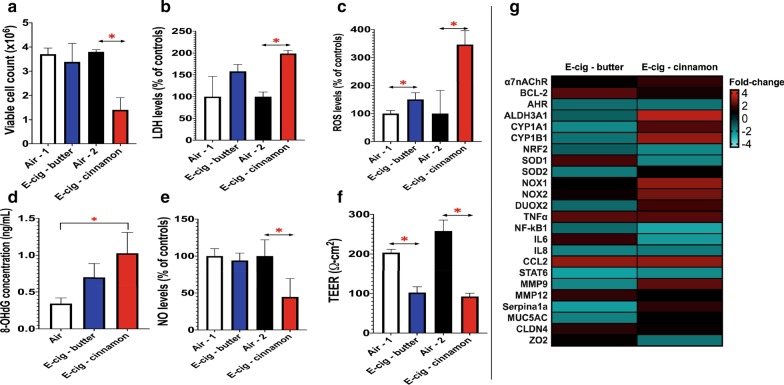Fig. 4.
1 Day of e-cig aerosol exposure under sub-ohm conditions (0.15 Ω & 4.8 V) affects the integrity of H292 cells’ tight junctions and revealed that cinnamon flavor is more cytotoxic and causes oxidative damage to a greater extent than butter flavored-e-cig aerosol. H292 cells were exposed to either butter- or cinnamon-flavored e-cig aerosol at the air–liquid interface (ALI) for 1 day. a Numbers of viable cells were significantly decreased by the cinnamon-flavored e-cig aerosol compared to respective air control. b Levels of extracellular lactate dehydrogenase (LDH) were significantly increased by the cinnamon-flavored e-cig aerosol compared to respective air control. c Levels of extracellular reactive oxygen species (ROS) were significantly increased by both butter- and cinnamon-flavored e-cig aerosols compared to their respective air control groups. d The extracellular protein concentration of 8-OHdG was significantly increased by the cinnamon-flavored e-cig aerosol compared to the air control group. This ELISA was analyzed for cell inserts (n = 3 per group). Each cell insert was further evaluated in duplicate. e Levels of extracellular nitric oxide (NO) were significantly decreased by the cinnamon-flavored e-cig aerosol compared to respective air control. f The transepithelial electrical resistance (TEER) values were significantly decreased by both butter- and cinnamon-flavored e-cig aerosols compared to their respective air control groups. For assays (a, b, c, f), data are from one experiment representative of results from three independent experiments, each performed in triplicate (n = 3 per group). For each cell insert, bioassays were further evaluated in duplicate or triplicate. For all assays (b–f), data were normalized to cell count and are presented as mean ± SEM. Comparisons between e-cig group and respective air control group were made by the student t-test; *p < 0.05: significantly different from respective air control. g Heatmap of the dysregulated genes by the e-cig aerosol exposures. Data are from H292 cells from distinct experiments. Data are presented as fold-change over the respective air-control group. Fold-changes > ± 1.5 were considered significant. Results from other independent experiments are represented in Additional file 1: Figures S2 to S5

